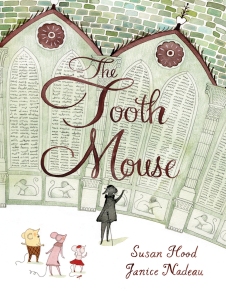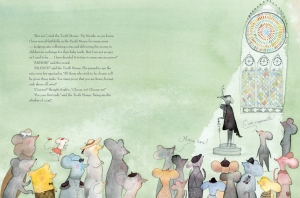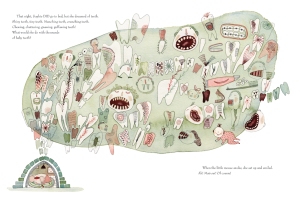
The Tooth Mouse, written by Susan Hood and illustrated by Janice Nadeau, is a fable that allows young readers to learn about another country’s version of the Tooth Fairy. The Tooth Mouse is ready to move on and Sophie, who is a dear little mouse has to prove that she is honest, brave, and wise enough to take on the succeed the present Tooth Fairy and take over the position. Over the course of 32 pages, she proves that she is capable.
Loosing teeth is one of those universal themes all kids can relate to since baby teeth must come out before the adult ones settle in for the duration of our lives. Any elementary school teacher knows just how much excitement there is about loosing a tooth. Therefore, I think this book will resonate with so many young readers. Plus, for any teacher who teaches a unit on fables, this text is sure to become a mentor for your classroom.
Susan Hood graciously answered questions for me via e-mail in the aftermath of Hurricane Sandy. (She lost power and kindly went to the library to respond to my questions.) I hope her responses give you more insight into why this book was created, how she developed the main character, and how she made code-switching work throughout the book. It is my hope that you’ll be able to use parts of this interview with your students if you decide to adopt The Tooth Mouse as a mentor text in your classroom.
Stacey: What inspired you to write a book about the tooth tradition from France?
Susan: I was writing a column for Nick Jr. Magazine called “Kids Like You” in which I interviewed kids around the world about their everyday lives. I asked six-year-old Sophie, a little girl in Paris, “What happens when you lose a tooth in France?” She said, “You give it to the Tooth Mouse, of course!” I had never heard of such a thing. The more I researched, the more I found that many countries (Algeria, Argentina, Belgium, the Dominican Republic, Mexico, Morocco, Russia, Spain, Slovenia, South Africa, Switzerland, Venezuela and more) have a Tooth Mouse instead of a Tooth Fairy. Italy has both!
I also discovered a 17th century story about the Tooth Mouse, La Bonne Petite Souris, written by Marie-Catherine d’Aulnoy. She was one of the most prolific fairy tale writers of the French Salons and the person credited with the term fairy tale (contes de fées). D’Aulnoy’s story is quite long, and like many fairy tales, it’s filled with murder, deceit and revenge. Don’t get me wrong. I loved fairy tales as a child and still do. But I wanted to write a younger, gentler story—my own modern tale with some wordless graphic novel elements—and yet include the quests and challenges I loved in books as a child. Et voilà! My Tooth Mouse got her name from the little girl who first told me about her.
Stacey: How did you develop the character of Sophie, who is a mouse? How is the character development work you did for her similar to and/or different than the character development you’d do for a human character?
Susan: Sophie looks and acts like a mouse; she’s small, dainty and agile. But emotionally, Sophie is a stand-in for a human protagonist. She experiences all the emotions of a young child who wants something badly and is a bit of an underdog. I wanted her to be a girl who uses both her talent and her wit to achieve her goal. One of my favorite reviews of the book in PW says, “Sophie’s ballet skills come in handy and yet her courage and intelligence win the day.”
Stacey: The dialogue in this book really moves the fable forward. What suggestions can you give to young writers about writing purposeful dialogue?
Susan: The Tooth Mouse issues her three challenges in dialogue, which makes them more immediate. Dialogue gives a scene more drama, a “You-are-there” quality. It invites readers into the scene so they can experience what your characters are experiencing.
My advice to young writers? When you write dialogue, avoid adverbs. Have the spoken words reflect the emotion behind them or follow up with an action that showsthe emotion. Here’s an example:
Instead of this:
“Très bien!” said the Tooth Mouse attentively.
Try this:
“Très bien!” said the Tooth Mouse, eyeing Sophie, the smallest contender with interest.
That action, of the Tooth Mouse eyeing Sophie, demonstrates her attentiveness and focuses our attention on Sophie as well.
Stacey: As a Francophile who studied French for over ten years, I love the way you embedded many French words and phrases in the text. First, how did you decide where and when to use French words or expressions? Second, why did you choose not to include clues to their meaning in the text or why there isn’t a translation guide in the back of the book?
Susan: I love introducing kids to new words and new languages. We live in such a global society, it’s important that kids get a taste of the world in their books. I used a little French to add Parisian flavor to the book and build the mise-en-scène.I believe we talked about adding translations, but decided they would be a distraction and disrupt the flow of the story. Many of the words I used are familiar to English speakers, either because they are ballet terms, such as jeté or they have similar counterparts in English, such as “impossible” or “felicitations!” After all, many English words are derived from French and both languages share Latin roots.
I love repeating words in picture books to encourage kids to chime in on the storytelling. That’s why I used “Mais non!” so frequently. It’s a thrill for kids to recognize repeating words AND to be able to speak a phrase in another language!
Stacey: Would you talk about the role questions play in this book?
Susan: Questions are meant to engage young readers, to get them to think about they would do in a similar situation.
Stacey: The ending of your book was satisfying. It made me smile, happy for Sophie’s new role in the world and also for what she did with all of those baby teeth. What advice can you give to children who are trying to craft the perfect ending to a fable they’re writing?
Susan: Thank you! My advice would be to try to think of the unexpected. Ask yourself, What would be a twist that would make readers smile, or better yet, laugh out loud when they turn that last page?
Stacey: The words and the pictures go along together brilliantly. Did you and Janice Nadeau collaborate?
Susan: Sadly, Janice and I have never met. I hope to remedy that some day! She is a brilliant illustrator. After all, she’s won the Governor General Awards for Illustration three times! As I mentioned, I was eager for the book to incorporate some wordless graphic novel elements—comic strip elements—to add a modern twist to the fable genre. My editor and I talked over what I envisioned for some scenes,such as the cat spread, and I was thrilled that Janice used some of those ideas and added so much more! All the beautiful watercolor details, the mice so full of personality and the gorgeous design elements were a delight. I love that Sophie is wearing the Tooth Mouse’s little black hat at the end.A nd that nightmare scene? Wow! When I read the book aloud, kids stop and stare and can’t stop talking about it.
Stacey: What are you working on now?
Susan: I’m excited that Kids Can Press will be publishing a new baby board book called TICKLY TOES in 2014. In addition, I have two books coming out from Hyperion, ROOTING FOR YOU in 2014 and LEAPS AND BOUNCE in 2015.
Now that you’ve learned more about Susan Hood and The Tooth Mouse take a peek inside of the book:


Giveaway information:
This giveaway is for a copy of The Tooth Mouse for one reader. Many for thanks to Kids Can Press for sponsoring this giveaway.To enter for a chance to win a copy of The Tooth Mouse each reader may leave one comment about this post in the comments section of this post.All comments left on or before Saturday, November 17th at 11:59 p.m. Eastern Time will be entered into a random drawing using a random number generator. I will announce the winner’s name at the bottom of this post by Tuesday, November 20th. Please be sure to leave a valid e-mail address when you post your comment so I can contact you to obtain your mailing address and have my contact at Kids Can Press send the book out to you. Please note: Your e-mail address will not be published online.
Comments are now closed.
Thank you to everyone who left a comment on this post. Congrats to Marcie Zambrysk whose commenter number was selected using a random number generator. Marcie said:
Being in first grade we are losing our teeth almost daily. We have read The Tooth Fairy, and I didn’t realize that another country has a tooth fairy title. Thanks for sharing this book and author with us.


I think my grandsons would love this, all 5 of them.
LikeLike
What a fun book for my granddaughter and also one to pass on to the graduate level teachers I teach…..
LikeLike
Being in first grade we are losing our teeth almost daily. We have read The Tooth Fairy, and I didn’t realize that another country has a tooth fairy title. Thanks for sharing this book and author with us.
LikeLike
This sounds like a really fun book. As a teacher, global perspective is really important in my classroom; hearing other languages and encountering history, customs and fresh viewpoints from another countries perspective. Thanks for sharing this book.
LikeLike
Thank you all for these wonderful comments! I’m delighted you like the book and want to share it with your students. I especially love your comment, Linda, about filing “a cavity in tooth fairy collections.” Very clever!
And thank you, Stacey, for your great questions!
LikeLike
Looks like a great mentor text addition for grade levels using fables etc.
LikeLike
I love the international flavor of this story. The endpapers with the world tooth customs really made me smile. This book will fill many a cavity in tooth fairy collections.
LikeLike
I love the French and love the illustration of all the teeth!
LikeLike
I am an American teaching English in a small former soviet country. I am always looking for ways to open up the world through wonderful stories, especially about children from other countries. This is a charming story and I would love to read this to my Young Learners.
LikeLike
I didn’t realize there were other tooth fairy type stories out there. I homeschool my five children using a language arts style approach and this book would make a lovely addition to our book collection.
LikeLike
I am always looking for a good mentor text. Sounds like this is a must for my collection!
LikeLike
I love the idea of this book! As a writing teacher and a Spanish teacher, this is a great way to introduce the culture of the countries around us. I also really appreciated the comment about adverbs. I often struggle with helping my students add in those details, but more subtly that saying it right out. (Show-not-tell, for example.) What a treasure of a book! Thank you for sharing!
LikeLike
I love the fact that the author uses French in her book!!! I speak the language, and it’s not often that you come across a book that uses uncommon French words. I can’t wait to read this book and share it with my staff and students!!
LikeLike
Love the ide!
LikeLike
This sounds like another book I buy for my Young 5’s and end up sharing with the whole school!
LikeLike